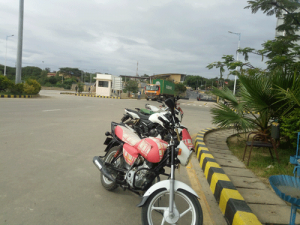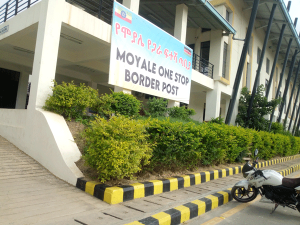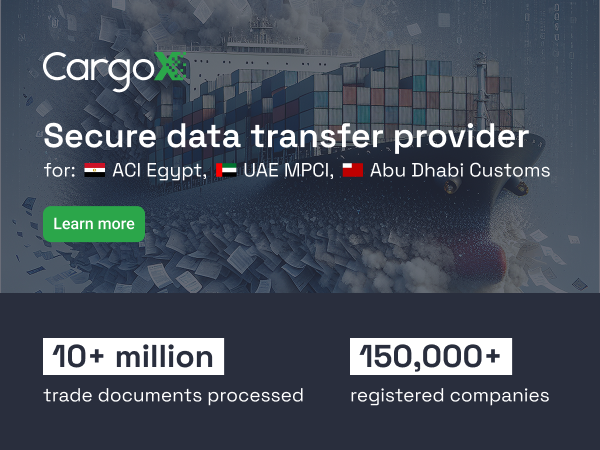Surveying stakeholders to assess procedures: overview of a field study carried out at Ethiopian borders
31 October 2024
By Daniel Tsegaye, Consultant, Addis Ababa, EthiopiaThis article presents the findings of a field study undertaken in 2021 at the border posts of Ethiopia with Kenya, Djibouti, and Somaliland. During the study, government officials and private sector representatives shared their views and perceptions on border management. Topics, ideas and practices that come up repeatedly were identified and are presented below. Overall, the study highlights the importance of formalized consultations and stakeholder engagement to enhance Customs processes.
Empirical studies highlight significant issues in border management practices in Ethiopia, including infrastructure deficiencies and bureaucratic hurdles[1]. Customs clearance has been reported to take a long time, with informal trade activities flourishing[2].
However, in recent years, significant reforms have transformed Customs procedures across East Africa, particularly in Ethiopia, Kenya, Somaliland, and Djibouti. In Ethiopia, Customs clearance processes have been streamlined and digitalized, leading to enhanced efficiency and reduced wait times[3]. In Kenya, a risk-based approach has been adopted[4]. In Somaliland, modernization efforts are ongoing, focusing on increasing regulation transparency and expediting cargo clearance, although challenges remain in implementation[5]. Djibouti, strategically positioned as a trade gateway, benefits from Customs regulations designed to facilitate rapid processing, supported by the Port of Djibouti’s significant capacity[6].
To better understand the situation, in 2021, as part of my university studies, I conducted a field study at three Ethiopian Customs posts: Tog Wajaale on the border with Somaliland, Galafi on the border with Djibouti, and Moyale on the border with Kenya.
My interest in border management had emerged during my studies in logistics and supply chain management, which I had started at Addis Ababa University in 2016. The field study was the final assignment of a master’s degree.
I selected these three border posts due to their importance in regional cross-border trade. Tog Wajaale, Galafi and Moyale serve as crucial transit points channelling the movement of goods and people between Ethiopia and its neighbouring countries. Due to their strategic locations, they play a key role in the economic dynamics of the Horn of Africa.
I used an observational research approach to conduct the study, directly observing border agencies’ practices, without directly intervening in the processes, and surveying 208 stakeholders involved in cross-border trade and border management to get information on their experiences and on how they perceived border management. Surveys were conducted using structured questionnaires administered face-to-face or electronically.
Moreover, I interviewed 15 government officials, Customs officers, and trade facilitation experts. These interviews were semi-structured, allowing flexibility to explore emerging themes and issues. They provided insights into policy perspectives, operational challenges, and potential solutions. Additional meetings were also conducted with officers working at Addis Ababa and Adama Customs offices and with Customs clearing agents, as well as with representatives of forwarding agencies and Ethiopian Shipping and Logistics Services Enterprise (ESLSE). Thematic analysis was used to analyse the collected information. Common themes – topics, ideas and practices that come up repeatedly – were identified and are presented below.
IT infrastructure and digital services
The Ethiopian Customs and Revenue Authority uses the Automated System for Customs Data (ASYCUDA) for processing Customs declarations, as well as other IT solutions to track shipments and manage tariff duties. Additionally, document management systems are used to digitally store, manage and retrieve documents, including import/export permits and invoices. Finally, the Customs IT system has been integrated with the systems used by other government agencies, port authorities, and logistics companies to facilitate smoother and more transparent border operations.
At the Ethiopian Customs posts located at Tog Wajaale (border with Somaliland), Galafi (border with Djibouti), and Moyale (border with Kenya), wireless connectivity ensures vital internet access, enabling electronic data exchange among traders, Customs agents, and other stakeholders involved in border management.

However, despite these advancements, several challenges persist.
Limited IT infrastructure is a major issue in Ethiopia, particularly in remote areas where power supply is lacking. Frequent system downtimes and slow internet speeds disrupt operations, leading to delays in Customs clearance.
Many Customs officers face significant challenges due to incomplete digitalization of procedures and insufficient IT skills. Several officers have reported a lack of proficiency in using the available IT services, which hinders their ability to process Customs transactions efficiently. This skills gap contributes to inconsistent performance in Customs processing, where officers struggle with complex digital systems and manual paperwork. The reliance on paper-based processes not only increases the volume of paperwork, but also extends approval times, leading to delays in Customs operations. Additionally, the situation is exacerbated by a shortage of staff and resources, which further strains the system and amplifies the impact of these skills deficiencies. Addressing these issues requires targeted training programmes to enhance digital literacy among Customs officers, and investment in upgrading infrastructure to support more efficient processing.
Another significant concern is software incompatibility between the systems used by national border agencies in Ethiopia, Kenya, Djibouti, and Somaliland. This lack of interoperability leads to a lack of data exchange between border posts, which brings in inefficiencies.
During the interviews, traders expressed a range of concerns about their ability to use sophisticated software due to insufficient training. The readiness to adopt digitalization varies significantly depending on the size of the company. Larger enterprises are generally better equipped with the necessary technology and digital skills, while smaller traders often face substantial barriers. These smaller traders frequently lack essential equipment, such as computers and reliable internet connections, primarily due to financial constraints. As a result, many still rely on paper-based methods for conducting operations.
This reliance on paper documents can be attributed to several factors. For some, it stems from a “cultural resistance” to change, where long-standing practices and familiarity with traditional methods make digital adoption challenging. For others, the limited access to technology and inadequate training exacerbate the issue.
Regarding the potential for smuggling, it is crucial to note that, while some traders may engage in illicit activities, the primary issue highlighted in the interviews revolved around the practical difficulties and resistance related to digitalization. There may not be a direct link between resistance to digital tools and smuggling activities, though inefficiencies in Customs processing can sometimes create opportunities for illegal activities.
Specific procedures for small traders are often designed to accommodate their limitations. These procedures might include simplified documentation processes or extended deadlines for compliance, aiming to balance the need for regulation with the practical challenges faced by smaller enterprises.
There seems to be a lack of trust. Some trade operators are concerned with data security and system reliability, fearing data loss. Some express a lack of trust in the authorities and fear heavy penalties if found non-compliant.
Inter-agency cooperation
The COVID-19 pandemic significantly impacted inter-agency cooperation at the Ethiopian borders with Somaliland, Djibouti, and Kenya, highlighting and exacerbating pre-existing issues.
This was especially the case between health and Customs authorities. In response to the pandemic, health authorities established health checkpoints at borders, requiring travellers to undergo health screenings and temperature checks. Customs authorities were tasked with enforcing these health regulations while simultaneously managing trade flows. Innovative solutions, such as the use of digital health passes and accepting documentation electronically instead of in paper format, were introduced to streamline processes, facilitating faster clearance while ensuring compliance with health guidelines.
However, individuals who were interviewed reported a lack of clear and consistent communication between health and Customs departments, leading to confusion about protocols and responsibilities. Procedures varied according to border posts, and rapid changes in pandemic-related regulations led to uncertainty among traders and Customs officials alike. Customs resources were strained and could not meet the new requirements for health screenings without causing delays in processing and contributing to a backlog of goods at border posts.
Corruption
Corruption remains a significant challenge at Ethiopian borders. Many traders and transporters reported that they tried to avoid paying high taxes imposed on legal trade by paying bribes. They said it was a question of pure survival. It is worth noting that illegal human trafficking has also been observed at these borders.
In interviews, both traders and Customs officers expressed significant concerns about the detrimental impact of corruption on their operations. They agreed that corruption fosters a murky environment where illicit activities can thrive, leading to inconsistent enforcement of regulations and unchecked illegal operations. Traders often feel constrained in reporting corrupt practices due to fears of retaliation and distrust in the reporting mechanisms, worried that exposing corruption might result in increased scrutiny or harassment. Despite these fears, they strongly desire reforms to improve transparency and streamline Customs procedures. Customs officers face similar challenges, encountering systemic corruption that undermines their ability to enforce regulations and may force them into complicity with illegal activities. Reporting corruption is also fraught with difficulties for them, including fear of repercussions and inadequate protection.
Both groups advocate for comprehensive systemic reforms, emphasizing the need for improved internal controls, enhanced oversight, and a more transparent and accountable environment. Reporting mechanisms vary: formal channels like whistleblower protection programmes exist but often lack effectiveness, while informal reporting through networks may be more common but less secure.

Risk management
Interviews with Customs offices and clearing and forwarding agents from Ethiopia and neighbouring countries revealed that controls are stringent and take a long time, creating bottlenecks and delays in the flow of legitimate goods, and inadvertently driving traders towards informal pathways.
While some Customs authorities are adopting advanced technologies and fostering cross-border cooperation to enhance risk management, there are still gaps in effectively utilizing risk assessment tools. Customs officers generally receive guidance from headquarters on cargo inspection, with directives based on risk factors such as shipment origin and cargo type. Advanced systems may use risk assessment tools to prioritize inspections, but officers sometimes exercise discretion within these guidelines. Monitoring of Customs officers involves internal audits, performance metrics, and adherence to procedural standards, with some regions also incorporating external oversight for added transparency. Despite these measures, controls are not always sufficiently selective, leading to inefficiencies in the inspection process.
Changing the situation would require Customs agencies to harmonize regulations, share data, train personnel in risk assessment, use technology for real-time monitoring of cargos, and promote trade operators’ compliance by increasing regulation transparency and offering training and guidance. Establishing feedback mechanisms with traders would further enhance risk evaluations by providing insights into compliance challenges.
Ongoing efforts to improve trade compliance increasingly focus on establishing public-private partnerships and engaging with informal traders. Public-private partnerships (PPPs) aim to unite government authorities and private sector entities to enhance trade facilitation and compliance, leveraging combined resources to streamline processes and improve regulatory frameworks. Initiatives might include joint technology platforms and training programmes, though challenges such as aligning diverse interests and ensuring transparency persist. Engagement with informal traders seeks to integrate them into the formal economy by simplifying regulatory processes and offering support and incentives for compliance. This approach helps address practical barriers and resistance to formalization but requires a nuanced understanding and tailored strategies. Effective improvement in trade compliance thus relies on comprehensive strategies and sustained commitment from both government and private sector stakeholders to address these challenges and facilitate smoother, compliant trade across regions.
Customs cooperation
Traders and Customs officers have reported significant inefficiencies due to inconsistent controls and lack of coordination between Customs administrations on either side of the border. Traders often experience being subjected to controls by both authorities for the same transaction, resulting in redundant inspections and delays. A typical border crossing process involves several steps: first, the trader submits documentation and the cargo declaration to the Customs authorities on the departure side. The shipment is then inspected, and, if cleared, it proceeds to the border crossing. Upon arrival at the destination border, the trader presents the same documentation and undergoes a similar inspection process.
Among solutions highlighted by interviewees were: harmonizing regulations and SOPs, integrating border management IT systems, organizing joint training, establishing integrated border posts, coordinating controls, sharing resources, collecting and diffusing best practices, providing training to trade operators jointly, and engaging with trade operators in a coordinated manner.
Cultural factors
Cultural diversity significantly influences Customs operations in East Africa, leading to distinct approaches being adopted locally that reflect the values, norms and practices of various communities.
For instance, in regions where informal trade is deeply ingrained in the local economy, Customs officers may adopt more flexible policies that accommodate traditional practices. This approach fosters goodwill and compliance among local traders who might otherwise resist formal regulations.
Conversely, in areas where there is a strong preference for transparency and legal adherence – often tied to historical experiences with corruption and governance – Customs officials rigorously follow procedures and rules, and companies have to align their practices.
Interviewees said that these cultural dynamics needed to be understood and taken into account by policymakers to develop tailored strategies that resonate with local communities, encouraging adherence to rules while respecting local practices. This sensitivity to local cultures would not only promote better compliance, but also strengthen the relationship between Customs authorities and local populations, ultimately contributing to a more harmonious and effective trading environment.
Informal sector
Informal trade refers to trade activities that occur outside the formal regulatory framework, conducted by unregistered businesses that do not comply with established tax and legal requirements. Informal traders encompass a wide range of individuals, from small-scale street vendors, smallholder farmers and micro-entrepreneurs to relatively large operators.
The nature of informal trade can vary significantly. Some activities may be purely innocuous, such as local artisans selling handmade goods, or farmers selling surplus produce directly to consumers. However, it can be linked to illicit activities such as the smuggling of goods, including stolen or illicit goods.
During interviews, some informal traders explained that they were operating outside the formal economy due to barriers such as high business registration costs, lack of information on the registration process and complex regulatory requirements. Some also declared that they were unaware of the benefits of establishing a formal entity, such as increased market access, protection of their rights, and eligibility for government support, such as tax break schemes or access to microfinance.
Validating findings
To ensure the accuracy and timeliness of these findings, I reached out to the Customs Administrations in each country. Feedback from Ethiopia is still pending, with initial communications established to clarify procedural reforms and address concerns about the lack of harmonization and cooperation at the border level. Kenya has confirmed its implementation of a risk-based enforcement model and recent technological advancements, though they have also acknowledged ongoing issues concerning lack of coordination and data exchange between border authorities. Detailed responses from Somaliland regarding their modernization initiatives are awaited, particularly concerning efforts to address border control inefficiencies and improve data sharing. Djibouti’s expedited processing procedures have been validated, corroborating findings related to enhanced maritime operations; however, Djibouti has also reported challenges concerning cross-border coordination, and a need for better harmonization of procedures with neighbouring countries. These responses highlight the overarching issue of inadequate cooperation and data exchange, which continues to affect the efficiency and effectiveness of border management across the region.
Way forward: promoting engagement with stakeholders
It is worth noting that finding and interviewing Customs officers and trade operators was challenging due to their busy schedules and to bureaucratic hurdles. Undertaking such a study required persistent follow-up and the development of personal networks. Securing necessary authorizations and clearances was also crucial, with the university providing essential support in navigating these challenges.
The field study highlighted the need to engage stakeholders in Customs modernization efforts, revealing that consultations in Ethiopia are not currently formalized, limiting their effectiveness. The Customs Administration acknowledges the importance of such consultations and is interested in the study’s findings, though detailed feedback is still pending.
More information
dnltsegaye@gmail.com
[1] See Brown, L., & Johnson, R. (2018). “Border Security and Informal Trade in the Horn of Africa.” Journal of Security Studies, 12(2), 89-106, and Tesfaye, A. (2017). “Customs and Border Management Challenges in the Horn of Africa: Case Studies from Ethiopia.” African Journal of International Affairs, 5(1), 78-95.
[2] See Girma, E., & Abebe, Y. (2016). “Policy Interventions and Trade Facilitation in Ethiopia: A Case Study of Border Management.” Ethiopian Journal of Economics, 24(2), 189-210.
[3] See World Bank. (2021). Doing Business 2021: Comparing Business Regulation in 190 Economies.
[4] See World Customs Organization. (2020). Risk Management in Customs Administration.
[5] See African Development Bank. (2019). Enhancing Trade Facilitation in the Horn of Africa.
[6] See International Maritime Organization. (2021). Maritime and Trade Facilitation Report on Djibouti.


